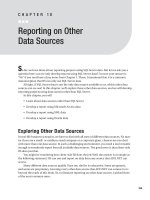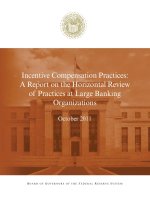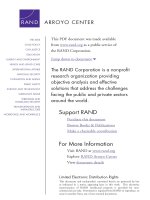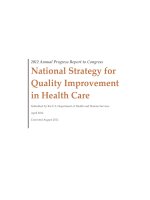NGFS PROGRESS REPORT ON BRIDGING DATA GAPS – EXECUTIVE SUMMARY
Bạn đang xem bản rút gọn của tài liệu. Xem và tải ngay bản đầy đủ của tài liệu tại đây (949.41 KB, 21 trang )
International Conference on "Statistics for Sustainable Finance", co-organised with the Banque de France and the Deutsche Bundesbank
14-15 September 2021, Paris, France, hybrid format
The NGFS (Network for Greening the Financial System) Progress Report
on Bridging Data Gaps and beyond1
Léa Grisey, Banque de France
1 This presentation was prepared for the conference. The views expressed are those of the author and do not necessarily reflect the views of the BIS, the IFC or the central banks and other institutions
represented at the event.
1/1
NGFS Progress report on bridging data gaps
Executive Summary
NGFS (Network for Greening the Financial System)
Key messages
Reliable and comparable climate-related data are crucial in order for financial sector
stakeholders to assess financial stability risks, properly price and manage climate-
related risks, and take advantage of the opportunities arising from the transition to a
low-carbon economy.
Persistent gaps in climate-related data hinder the achievement of these objectives.
Stakeholders report the need for more forward-looking data (for example targets or
emissions pathways) and granular data (for example geographical data at entity and
asset-levels). Stakeholders are also calling for some assurance about the quality of
climate-related data through verification and audit mechanisms, as well as
improvements in data accessibility.
A mix of policy interventions is needed to catalyse progress towards better data,
based on the following three building blocks:
i. rapid convergence towards a common and consistent set of global
disclosure standards;
ii. efforts towards a minimally accepted global taxonomy;
iii. the development and transparent use of well-defined and decision-useful
metrics, certification labels and methodological standards.
Global progress on the aforementioned building blocks that the NGFS is calling for
should not prevent better leveraging of already available data sources and
approaches (such as e.g. proxies and estimates, qualitative approaches and capacity
building), as well as the promotion of new data tools.
The NGFS will continue its evidence-based identification of the most prevalent data
gaps – including by further engaging with other stakeholders such as non-financial
corporates, data providers and ratings agencies – and to issue recommendations on
how to bridge them.
NGFS Progress report on bridging data gaps – Executive Summary 1
Contents
NGFS Progress report on bridging data gaps ............................................................................. 1
Executive Summary................................................................................................................................. 1
Climate change and the data challenge......................................................................................... 3
Mandate and work programme of the Workstream on bridging the data gaps (WS
BDG)...................................................................................................................................................... 3
A repository of data needs .................................................................................................................. 4
Key issues related to data availability, reliability and comparability................................... 5
Building blocks to bridge the data gaps........................................................................................ 6
Disclosure frameworks ................................................................................................................. 6
Taxonomies ...................................................................................................................................... 7
Certification labels, methodological standards and consistent metrics................... 8
Leveraging existing data sources and approaches .................................................................... 8
Next steps................................................................................................................................................... 9
2 NGFS Progress report on bridging data gaps – Executive Summary
Climate change and the data challenge
Reliable and comparable climate-related data are crucial for financial
institutions (including central banks and supervisors), investors and
policymakers to assess financial stability risks, properly price and manage
climate-related risks, and take advantage of the opportunities arising from the
transition to a low-carbon economy. Such climate-related data are key for
microprudential and macroprudential supervision. They also enable financial
institutions and investors to gauge the financial repercussions of climate change and
increase their resilience to climate-related risks. Moreover, they enable financial
institutions to ensure that sufficient capital is made available for the investments
needed to achieve the goals of the Paris Agreement.
Persistent gaps in climate-related data hinder the achievement of these
objectives. The need to find solutions for data gaps has garnered significant
attention and led to a renewed sense of urgency, as pressure continues to grow
to address climate change from investors, researchers, regulators and
policymakers, as well as NGOs and the general public. These data gaps have
multiple causes, which include the time horizon for climate-related risks, the
widespread nature of their impact and the high degree of uncertainty surrounding
them, as well as the need to translate climate-related risks into financial impacts.
Mandate and work programme of the Workstream on
bridging the data gaps (WS BDG)
The Network for Greening the Financial System (NGFS) set up the Workstream
on bridging the data gaps (WS BDG) in July 2020 to identify climate-related
data needs and data gaps and to propose policy recommendations to bridge
such gaps. The WS BDG represents the implementation of Recommendation n° 3
“Bridging the data gaps” issued in April 2019 in the First comprehensive report by the
NGFS. More specifically, inline with its mandate, the work of the WS BDG is structured
according to the following three-phase approach:
i. Identify data items needed by the financial sector –including central
banks and supervisors – for the purpose of climate-related risk analysis
and the scaling up of green finance.
ii. Determine whether the data items are available, and if so, identify their
data sources and limitations for accessing them.
iii. Provide guidance and recommendations on how to bridge the data gaps
identified.
This Progress report forms part of the first phase of the Workstream’s work
programme and, in setting out the issues that need to be considered going
forward, lays the groundwork for a comprehensive assessment of climate-
related data needs and gaps. The Workstream completed a systematic literature
review, undertook outreach to a variety of international organizations and other
relevant stakeholders, and conducted a survey and two closed-door workshops with
banks and buy-side firms. Given the breadth and magnitude of climate-related risks,
and the urgent need for action, this report is narrowly focused on climate-related
NGFS Progress report on bridging data gaps – Executive Summary 3
data issues, both at a granular level (such as firm-level data and asset-level
exposures) and at an aggregate level (such as data on the incidence of natural
disasters at the regional or country level). Broader environmental data issues, for
example those related to biodiversity, may be addressed in the future. It should be
noted that climate change research, methodologies and metrics for application in
the financial sector are evolving quickly and further data needs will continue to
emerge over time.
A repository of data needs
The NGFS has adopted a user-centric approach informed by interactions with
a vast number of stakeholders1 from a wide range of geographies and areas
of expertise. As data gaps are cross-cutting issues that affect a large number of
public and private sector stakeholders, a user-centric approach represents a
transparent and open-ended starting point to jointly determine what data are
needed across stakeholders. This report proposes a classification of a number of use
cases that define the application of climate-related data for key stakeholder groups
in the financial sector. Identifying these use cases, understanding what metrics and
methodologies support them, and relating them to the raw data items that feed
those metrics are key for systematically mapping the data needs, and subsequently,
the data gaps. To this end, the Workstream has set up a three-layered repository of
data needs in which detailed results for use cases, metrics, and raw data items are
recorded. The repository will play an important role in phases 2 and 3 of the work
programme and will allow the NGFS to draw conclusions about which data gaps to
prioritize. A schematic overview of the data repository is presented in Figure 1.2
Interconnectedness of use cases, metrics and raw data items by stakeholder
category in the repository
1 Note that, at this stage, the liability side of the insurance sector is not included in this assessment.
2 This figure gives a schematic overview of the data repository: from left to right, it shows the six
stakeholder categories, their use cases for climate-related data, the metrics required to support the
use cases, and the raw data items that feed the metrics.
4 NGFS Progress report on bridging data gaps – Executive Summary
Key issues related to data availability, reliability and
comparability
Meeting stakeholders’ climate-related data needs for the identified use cases is
a multifaceted challenge, which warrants comprehensive consideration across
three dimensions: availability, reliability and comparability.
With regard to availability, stakeholders need climate-related data across asset
classes, sectors and geographies, and over different timeframes. In some instances,
relevant data sources lack the appropriate granularity, and/or the geographical or
sectoral coverage. In other instances, relevant data sources exist, but are not collected
in a consistent manner, are not directly accessible, cannot be easily compared or may
produce varying outcomes. As for reliability, numerous studies3 have shown that the
available data sources and metrics generally produce scattered and inconsistent
outcomes. Reliability depends on the quality of the raw data, as well as the auditability
and transparency of the providers. For example, more transparency about how ESG
scores are determined would enable the sometimes large differences in the scores of
different data providers to be better understood. Lastly, with regard to
comparability, differences in the design and focus of the multiple frameworks for
climate-related disclosures, as well as a lack of consistency, can make it challenging
for end-users when they need to compare the information reported across different
frameworks.
The findings of the interaction with stakeholders suggest that the largest data
gaps exist for forward-looking data, such as emissions pathways and
companies’ transition targets (including interim targets). Given the importance
of forward-looking assessments of both physical and transition risks, the current
reliance on mostly backward-looking data is unsatisfactory. Stakeholders reported
3 For more information, please see Box 3 on “Comparability and transparency issues in practice” in the
NGFS Progress report on bridging data gaps
NGFS Progress report on bridging data gaps – Executive Summary 5
that they need to understand the point-in-time performance of an exposure against
a transition pathway – hence the need for firms to disclose their transition plans – as
well as the impact of adaptation and mitigation measures on the evolution of the
risks.
Stakeholders also highlighted the currently limited availability and granularity
of “carbon” data (such as Scope 3 emissions, data on avoided emissions) and
geographical data on asset locations, to assess both transition and physical risks.
Since there are large geospatial differences in the manifestation and evolution of
physical risks, it is critical to make asset location data available to determine the
variety and severity of the physical threats of climate change.
Building blocks to bridge the data gaps
To ensure the availability of reliable and comparable climate-related data, a mix
of policy interventions is needed to catalyse progress. Three building blocks are
paramount:
1) rapid convergence towards a common and consistent set of global
disclosure standards;
2) efforts towards a minimally accepted global taxonomy; and
3) the development and transparent use of well-defined and decision-
useful metrics, certification labels and methodological standards.
Many of the stakeholders with which the Workstream has interacted during the first
phase of its work programme have made policy suggestions for bridging the data
gaps: policymakers should take urgent steps to improve climate-related disclosures
and strive to converge towards a set of consistent global standards and disclosure
requirements. They should also aim to achieve a minimally accepted global taxonomy
to enhance reliability, availability and comparability of reported data. Moreover,
relevant and consistent metrics and methodological standards are important for the
development of disclosure standards.
Disclosure frameworks
While some progress has been made in recent years, climate-related disclosures
by financial and non-financial companies are still limited, fragmented and
inconsistent across economic sectors. Financial institutions stress the degree to
which they rely on disclosures from the wide range of corporates that they invest in,
lend to or insure. It is essential for them to have access to information regarding the
climate risks and opportunities faced by the corporates they are exposed to.
Meanwhile, corporates also face challenges in providing climate-related data to their
stakeholders amid a fragmented landscape of still largely voluntary disclosure
frameworks. The main issues identified relate to the voluntary nature of disclosure
frameworks, the fragmentation in the landscape, the absence of technical guidance
and independent verification, and the lack of a common approach to materiality.
Moreover, different definitions and thresholds for materiality with respect to climate
issues also affect the availability of climate-related data.
6 NGFS Progress report on bridging data gaps – Executive Summary
Convergence towards a global disclosure framework, alongside progress
towards a globally consistent set of minimal climate disclosure standards and
requirements is likely to improve the availability and comparability of climate-
related data. A stronger push for consistency across sectors and regions, and an
appropriate scope for disclosures is a prerequisite for an adequate disclosure
framework for the financial sector. Notably, at the beginning of 2021 the IFRS
Foundation announced a plan to establish a sustainability standards board with
support from IOSCO and building on existing frameworks, such as the Task Force on
Climate-related Financial Disclosures (TCFD) and the prototype developed by the
“group of five”, namely the Carbon Disclosure Project (CDP), Climate Disclosure
Standards Board (CDSB), Global Reporting Initiative (GRI), the International Integrated
Reporting Council (IIRC) and the Sustainability Accounting Standards Board(SASB).4
This will pave the way for greater consistency and the convergence of sustainability-
related financial reporting standards, with climate standards being prioritised.
Mechanisms for verifying and auditing climate-related financial disclosures are
essential to make data reliable and comparable. The development of sufficiently
granular methodological standards that prescribe how data items are defined and
how metrics are to be computed is a precondition for assuring the quality of
disclosures. In turn, external assurance of such information facilitates the appropriate
application of standards and definitions. Some stakeholders have called for an
assurance framework similar to the one for financial statements and its integration in
mainstream financial reporting.
Taxonomies
Taxonomies are another building block in improving data reliability and
comparability, and therefore providing financial institutions and investors with
relevant information. Many stakeholders consider developing taxonomies as a
prerequisite for consistent collection of data and comparable analysis based on these
data. Currently, different jurisdictions are establishing different, separate taxonomies
for green finance, including pathways and targets that are relevant in their regional
context. Many stakeholders point to the need to recognize transition pathways in
taxonomies, as a way of catering for differences in regional starting points and
facilitating transition financing for companies and other economic players that aim to
improve their environmental impact. Other stakeholders questioned the added
complexity this would bring to the task of developing a minimally accepted
harmonized taxonomy and suggested that disclosing the pathways and distance to
targets would be an easier way forward. There is therefore a need for cross-regional
discussion on taxonomies. Efforts towards developing a globally agreed upon
taxonomy could help ensure worldwide comparability of raw data. The convergence
of different taxonomies over time will be important in ensuring consistency in
climate-related disclosures.
There is a need to intensify and coordinate the development of taxonomies
across the globe, and to examine the possibility of harmonizing them over time.
Such efforts need to be intensified and well-coordinated, especially in regions where
taxonomies do not yet exist. These are important steps towards the development of
4 For information on the prototype developed by the “group of five“, see Reporting on enterprise value,
Illustrated with a prototype climate-related financial disclosure standard, December 2020.
NGFS Progress report on bridging data gaps – Executive Summary 7
a global taxonomy. Limiting the scope to that of a climate-related taxonomy first (as
opposed to including issues such as biodiversity which could well be added as a next
step) may be a pragmatic way forward. For example, the International Platform on
Sustainable Finance has created a dedicated working group on taxonomies to
comprehensively compare existing European and Chinese taxonomies for
environmentally sustainable investments and identify commonalities and differences
in their respective approaches, criteria and outcomes.
Certification labels, methodological standards and consistent metrics
Certification labels5 and harmonized methodological standards are key to
improving data reliability and comparability. They can make it easier to identify
climate-related data and construct datasets (for example, energy efficiency
certificates). Certification labels should be harmonized across regions and the
information they certify should be made comparable, homogeneous and easily
available.
Data comparability is also enhanced when financial market participants
harmonize their approaches. The methodologies and disclosure frameworks
observed by the NGFS often rely on different computation methods, even for key
metrics used across stakeholders and geographies. Such divergences can hinder the
comparability of climaterelated data, with a profound effect on the outcomes of
analyses, especially as transparency regarding the methods adopted is limited. For
example, De Nederlandsche Bank has recently shown that inflation and exchange rate
effects can have a substantial impact on the outcomes of relative carbon footprint
metrics.6 If inancial market participants adopt harmonized approaches, this supports
the comparability of data. It is worth noting that a number of initiatives have led to
open source methodologies and voluntary methodological standards being
produced which are then widely used. For example, one such methodological
standard is the attribution methodology for the computation of financed emissions
by the Partnership for Carbon Accounting Financials (PCAF), which has been
embraced by the Greenhouse Gas (GHG) Protocol.
Leveraging existing data sources and approaches
The NGFS notes that there is substantial scope for financial institutions to better
leverage already available data sources and approaches. Notwithstanding the
need to make progress on the three aforementioned building blocks, financial
institutions can also make better use of proxies and estimates, as well as qualitative
approaches, while they build up capacity to enhance their ability to process climate-
related data. Moreover, many existing approaches might be usefully applied in any of
5 A certification label is a label or symbol indicating that compliance with standards has been verified.
Use of the label is usually controlled by the standard-setting body. Where certification bodies certify
against their own specific standards, the label can be owned by the certification body. Examples are
Energy Performance Certificates or ISO standards.
6 See Janssen, A., Dijk, J. and Duijm, P., “Misleading Footprints, Inflation and exchange rate effects in
relative carbon disclosure metrics”, DNB Occasional Paper, Vol. 19(1), 28 January 2021.
8 NGFS Progress report on bridging data gaps – Executive Summary
these building blocks. For instance, voluntary standards developed in the markets
might provide to be valuable building blocks for harmonized disclosure frameworks.
The promotion of new data tools and analytics, and more generally
digitalization, as well as repositories to make data collection more transparent
are also useful. The development of new data tools can provide technical solutions
for accessing data, and repositories could be helpful in pointing to existing climate-
related data. Indeed, many stakeholders emphasized that they often face technical
obstacles when working with climate-related data. Access to existing climate-related
data is often difficult, because data are scattered across different sources and/or only
available via private data providers. Publicly available repositories could be helpful as
a way of pointing to existing climate-related data and informing users on how best
to access relevant data sources. Solutions such as open source architecture for data
collection and distribution and machine learning techniques may also play a role in
making scattered information available in a more structured format. However, more
work needs to be done to make existing data more broadly available to policymakers
and investors. To date, several initiatives have been launched with a view to pooling
climate-related raw data in a single point (see Box 10 in the Progress report on
bridging data gaps for a case study in Mexico). It would be worth examining how
these can improve data availability and comparability.
Next steps
Identifying and prioritizing data needs: use cases, metrics that serve the use
cases and the raw data items needed for those metrics
The NGFS will further expand its engagement with stakeholders and, using the data
repository, aims to draw evidence-based conclusions about which data needs should
be prioritized. To this end, the NGFS will:
• engage with a broad set of stakeholders, including non-financial corporates
(which constitute the first input in the data chain), central banks and
international financial institutions (whose statistical functions are key to help
bridge the gaps), data providers and rating agencies, in order to determine
whether the data needs identified can be addressed and, if not, how the gaps
can be bridged;
• further assess the types of metrics that are most suited to support the
different use cases identified in the first phase. style, paragraph style,
paragraph style.7
Meeting data needs across three main data dimensions: availability, reliability
and comparability
Going forward, the NGFS will:
• examine possible recommendations for increasing data availability, including
initiatives that make data available free of charge or at nominal cost to cover
data processing;
NGFS Progress report on bridging data gaps – Executive Summary 9
• consider the types of verification scheme that could enhance the quality of
raw data items, and issue recommendations for achieving greater
transparency and comparability on methodologies.
Developing policy recommendations to help bridge data gaps
The NGFS will, in liaison with relevant stakeholders:
• identify how the progressive harmonization of metrics and methodological
standards, certification labels and taxonomies can contribute to the reliability
and comparability of data, together with a wider implementation of
mandatory disclosures in financial statements. In doing so, the NGFS will
engage with relevant stakeholders, including non-financial corporates and
methodologies providers;
• examine how publicly accessible databases can improve data availability and
comparability. In doing so, the NGFS will reach out to initiatives that pool
climate-related raw data in a single point and to relevant stakeholders in
thefield of geospatial data, paying specific attention to the use of new
technologies (such as artificial intelligence).
10 NGFS Progress report on bridging data gaps – Executive Summary
International Conference on
“Statistics for Sustainable Finance”
The NGFS Progress Report on Bridging Data
Gaps and beyond
International Conference on « Statistics for Sustainable Finance » ‐ Paris 14 & 15 September 2021
THE NGFS AND THE WORKSTREAM ON BRIDGING THE DATA GAPS
Established at the Paris “One Planet Summit” in December 2017.
Coalition of the willing comprised of 95 members and 15 observers,
from all 5 continents.
Defines and promotes best practices and conducts analytical work on the
management of climate‐related risks and on green finance.
Main publications: First comprehensive report issuing 6 non‐binding
recommendations, practical guides, two vintages of ‘NGFS scenarios’…
In the recommendation #3 of its First comprehensive report (April 2019), the NGFS stated “to see
merit in setting up a joint working group with interested parties to bridge existing data gaps”.
The Workstream BDG was set up in July 2020 to turn this recommendation into practice. It is
aimed at identifying and prioritizing climate‐related data needs and gaps, and at proposing policy
recommendations to bridge these gaps. It is co‐Chaired by Fabio Natalucci (IMF) and Patrick Amis
(SSM/ECB).
International Conference on « Statistics for Sustainable Finance » ‐ Paris 14 & 15 September 2021
OVERVIEW OF THE PROGRESS REPORT ON BRIDGING THE DATA GAPS
The Progress Report:
→ is based on a systematic literature
review, an outreach to other NGFS
workstreams, a variety of IOs and other
relevant stakeholders;
→ incorporates information gathered
through a survey and two closed‐door
workshops with banks and buy‐side
firms;
→ lays the groundwork for a comprehensive
assessment of climate‐related data
needs and gaps.
International Conference on « Statistics for Sustainable Finance » ‐ Paris 14 & 15 September 2021
THE WORKSTREAM APPROACH (1/3)
We adopted a user‐centric approach – informed by the literature review’s findings
and interactions with stakeholders – aimed at identifying in a systematic way the
needs of climate‐data users in the financial sector.
The Progress Report proposes a classification of six stakeholder categories and six
main use cases for which stakeholders have indicated climate‐related data needs.
Stakeholder categories Use cases
Central banks Exposure quantification
Supervisors Investment and lending decisions
Credit institutions Macroeconomic modelling
Insurers Financial stability monitoring
Pension funds Climate‐related disclosures
Other buy‐side entities
Scenario analysis and stress
testing
International Conference on « Statistics for Sustainable Finance » ‐ Paris 14 & 15 September 2021
THE WORKSTREAM APPROACH (2/3)
The BDG has set up a three‐layered repository of data needs, in which we recorded
detailed results for use cases, metrics and raw data items across the six main
stakeholder categories.
Schematic overview of the layered structure of the repository
Going forward, the repository is aimed at providing an evidence‐based overview of
climate‐related data items that need to be bridged with priority.
International Conference on « Statistics for Sustainable Finance » ‐ Paris 14 & 15 September 2021
THE WORKSTREAM APPROACH (3/3)
The figure below shows the interconnectedness of use cases, metrics, and raw data
items by stakeholder category in the repository.
While preliminary, it gives a sense of commonalities in use cases and data needs
among stakeholders, and of how the repositary can be used to highlight priorities.
Schematic overview of the repository
International Conference on « Statistics for Sustainable Finance » ‐ Paris 14 & 15 September 2021
WHAT WE HAVE LEARNED SO FAR
Meeting data needs for the identified use cases is a multifaceted challenge that
warrants comprehensive consideration across 3 dimensions: availability, reliability
and comparability.
Main data challenges highlighted during interactions with stakeholders:
‐ largest data gaps exist for forward‐looking data (e.g. emissions pathways,
targets);
‐ limited availability and granularity of “carbon” data (e.g. Scope 3 emissions)
and of geographical data on asset locations to assess both transition and
physical risks;
‐ stakeholders are also calling for some assurance about the quality of climate‐
related data through verification and audit mechanisms, as well as
improvements in data accessibility.
International Conference on « Statistics for Sustainable Finance » ‐ Paris 14 & 15 September 2021
BUILDING BLOCKS TO BRIDGE THE DATA GAPS (1/2)
To ensure the availability of reliable and comparable climate‐related data, a mix of
policy interventions is urgently needed to catalyse progress and foster global
convergence.
Three building blocks are paramount.
Three main building blocks to bridge the data gaps
International Conference on « Statistics for Sustainable Finance » ‐ Paris 14 & 15 September 2021
BUILDING BLOCKS TO BRIDGE THE DATA GAPS (2/2)
Building a proper architecture for climate data information around the three
building blocks should not prevent leveraging the existing data sources and
approaches.
Promoting new data tools and analytics (e.g. open source repositories, AI) to make
data collection more transparent is also useful.
Leveraging existing sources and approaches and promoting new tools
International Conference on « Statistics for Sustainable Finance » ‐ Paris 14 & 15 September 2021









